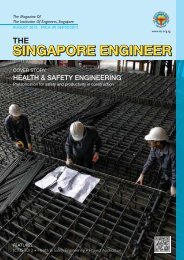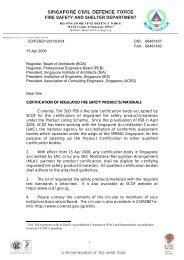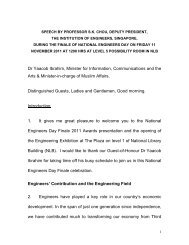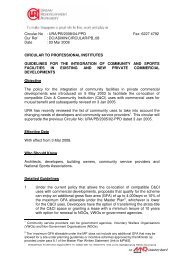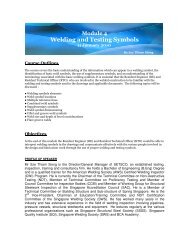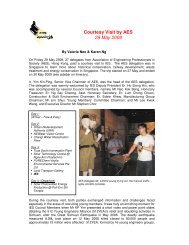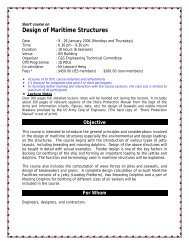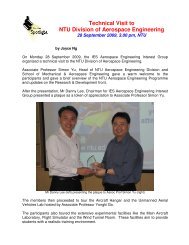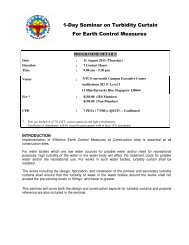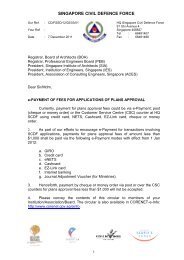News & Events - Institution of Engineers Singapore
News & Events - Institution of Engineers Singapore
News & Events - Institution of Engineers Singapore
Create successful ePaper yourself
Turn your PDF publications into a flip-book with our unique Google optimized e-Paper software.
Interview<br />
Arup’s rail engineering capability<br />
is allowing us to assist <strong>Singapore</strong> in<br />
meeting its vision <strong>of</strong> developing a worldclass<br />
transportation system, particularly<br />
the Downtown MRT Line project where<br />
we have provided a range <strong>of</strong> services from<br />
alignment and routing studies to detailed<br />
engineering design.<br />
Q: How is Arup approaching the issue<br />
<strong>of</strong> sustainability?<br />
A: In the early 1970s, Sir Ove Arup, our<br />
founder, was one <strong>of</strong> the first people to<br />
talk <strong>of</strong> ‘sustainability’. So, sustainability<br />
is not new to Arup.<br />
Our design teams are working<br />
together to investigate ways to reduce<br />
energy demands. Through careful<br />
design <strong>of</strong> the facades for projects like<br />
the National Library, One George Street<br />
and 20 Anson, solar thermal loads on<br />
the building are minimised by reducing<br />
the cooling needed from airconditioning<br />
systems. Carefully positioned sunshades<br />
project natural daylight into the spaces<br />
within the building, thus saving electricity<br />
to run artificial lights.<br />
However, the greatest energy<br />
savings would come from avoiding<br />
airconditioning altogether. This is cleverly<br />
achieved by permitting the passage <strong>of</strong><br />
natural breezes for the integrated civic,<br />
cultural, retail and entertainment hub<br />
(CCRC) and by providing assisted<br />
ventilation and heat-reflecting canopies<br />
for Clarke Quay’s streetscape.<br />
As the <strong>Singapore</strong> and other Asian<br />
property markets become more mature<br />
and sophisticated, increasingly the life <strong>of</strong><br />
commercial buildings is being extended<br />
Arup <strong>Singapore</strong> Pte Ltd<br />
Arup opened its <strong>Singapore</strong> <strong>of</strong>fice in<br />
1968. Over the years, the firm has<br />
made significant contributions to<br />
landmark projects such as OCBC<br />
Centre, UOB Plaza, Temasek Towers,<br />
Expo MRT station, <strong>Singapore</strong> Expo,<br />
and the National Library Building.<br />
The company’s other projects in<br />
<strong>Singapore</strong> include the <strong>Singapore</strong> Flyer,<br />
Fusionopolis, ION Orchard, Marina<br />
Bay Sands Integrated Resort, The Helix<br />
bridge, Gardens by the Bay, <strong>Singapore</strong><br />
Sports Hub, School <strong>of</strong> the Arts, and<br />
the renovation <strong>of</strong> Victoria Theatre and<br />
Victoria Concert Hall.<br />
Arup<br />
Founded by Sir Ove Arup in 1946,<br />
by retr<strong>of</strong>itting and refurbishment. The<br />
Green Building agenda, along with<br />
a tighter financial environment will<br />
increase this trend.<br />
Arup has studied the factors that<br />
influence client decisions, and have<br />
recently worked with the BCA to prepare<br />
a guide book targetted at owners’ existing<br />
buildings as part <strong>of</strong> their Green Building<br />
Guide Platinum Series.<br />
with an initial focus on structural<br />
engineering, Arup has become a<br />
global design, engineering, and<br />
business consultancy, with a staff <strong>of</strong><br />
over 10,000 spread over 92 <strong>of</strong>fices in<br />
37 countries.<br />
The firm first came into prominence<br />
with the structural design for the<br />
Sydney Opera House in Australia,<br />
followed by its work on the Centre<br />
Pompidou in Paris, France. Arup has<br />
since grown into a multidisciplinary<br />
organisation. Most recently, the firm’s<br />
contributions to the 2008 Olympics<br />
facilities in Beijing, China, particularly<br />
the National Aquatics Center (Water<br />
Cube) and the Beijing National<br />
Stadium (Bird’s Nest), have served to<br />
reaffirm its reputation.<br />
On the right <strong>of</strong> the picture, The Helix is set against the backdrop <strong>of</strong> the Marina Bay Sands Integrated Resort. Image by Darren Soh.<br />
THE SINGAPORE ENGINEER Jun 2010 · 31



